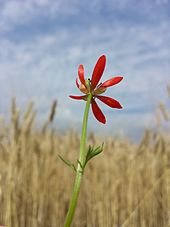Flame Adonis
| Flame Adonis | ||||||||||||
|---|---|---|---|---|---|---|---|---|---|---|---|---|

Flame Adonis ( Adonis flammea ) |
||||||||||||
| Systematics | ||||||||||||
|
||||||||||||
| Scientific name | ||||||||||||
| Adonis flammea | ||||||||||||
| Jacq. |
The Flaming Adonis ( Adonis flammea ), also known as Scarlet Adonis , Burning Devil's Eye or Burning Adonis , is a species of plant from the genus Adonis ( Adonis ) in the buttercup family (Ranunculaceae). The Flaming Adonis ( Adonis flammea ) can be confused with the very similar Summer Adonis ( Adonis aestivalis ), but it is much rarer.
description

Adonis flammea grows as an annual herbaceous plant and reaches heights of (10 to) 20 to 50 centimeters. The upright, simple or branched stems in the lower third are slightly hairy, especially at the base (in the Summer Adonis, however, mostly bald). The alternate arranged on the stem leaves are three to four times fiederteilig.
The terminal flowers are single. The hermaphrodite flowers are radially symmetrical with a diameter of 1.5 to 3.5 centimeters . The sepals are long haired at the base and later bald. The sepals have - unlike in the summer Adonis - an adjacent hair. The three to eight petals are scarlet to blood red, rarely yellow and occasionally have a dark spot on the base. The eight stamens are dark purple.
In a collective fruit there are loosely distributed nuts with a round hump at the tip, which pushes the black beak to the side (the beak is green in the summer Adonis flower).
The number of chromosomes is 2n = 32.
Occurrence and endangerment
The distribution area of the Flammen-Adonisröschens extends between southern Europe and western Asia . Its northern border is around the 51st parallel, in the west it reaches France and northern Spain , in the south Sicily , Egypt and Asia Minor , and in the east the Caucasus region and northern Iran .
The Flame Adonis is warmth-loving and a lime hand . The Flame Adonisröschen thrives best on lime-rich, shallow-rocky, summer-warm loam , loess or clay soils . In Central Europe it populates grain fields , less often root crops or wasteland . In Central Europe it is a character species of the Caucalido Scandicetum from the Caucalidion association. Chemical weed control has made it rare in Central Europe ; there it occurs only sporadically and inconsistently in the limestone areas of the low mountain range. The number of sites where this species was found after the Second World War has decreased dramatically.
The Flame Adonis rose probably came to Germany during the Neolithic Age ( archaeophyte ) and was common earlier. As a result of intensified cultivation methods, it has only been found very scattered in Germany for decades. Adonis flammea was rated in 1996 in the Red List of Plants in Germany with category 1 (= threatened with extinction).
In Austria the Scarlet Adonis occurs very rarely, especially in the Pannonian region . The occurrences are limited to the federal states of Vienna , Lower Austria , Burgenland and Tyrol . It is considered endangered and in the alpine area and in the northern and southeastern Alpine foothills as threatened with extinction.
ingredients
Like the other representatives of the genus, Adonis flammea is poisonous, especially due to its content of cardiac glycosides ( cardenolides ), with adonitoxin and cymarin being the main glycosides.
swell
- Martin Hanf: color atlas field flora. Wild herbs and weeds. Eugen Ulmer, Stuttgart 1990, ISBN 3-8001-4074-8 .
- Oskar Sebald, Siegmund Seybold, Georg Philippi (Hrsg.): The fern and flowering plants of Baden-Württemberg . tape 1 : General Part, Special Part (Pteridophyta, Spermatophyta): Lycopodiaceae to Plumbaginaceae . Eugen Ulmer, Stuttgart (Hohenheim) 1990, ISBN 3-8001-3309-1 .
- Flame Adonis. In: FloraWeb.de.
- Manfred A. Fischer, Karl Oswald, Wolfgang Adler: Excursion flora for Austria, Liechtenstein and South Tyrol . 3rd, improved edition. State of Upper Austria, Biology Center of the Upper Austrian State Museums, Linz 2008, ISBN 978-3-85474-187-9 .
Individual evidence
- ↑ a b Erich Oberdorfer : Plant-sociological excursion flora for Germany and neighboring areas . 8th edition. Verlag Eugen Ulmer, Stuttgart 2001, ISBN 3-8001-3131-5 . Page 421.
- ↑ a b Dietmar Aichele, Heinz-Werner Schwegler: The flowering plants of Central Europe . 2nd Edition. tape 5 : Swan flowers to duckweed plants . Franckh-Kosmos, Stuttgart 2000, ISBN 3-440-08048-X .
Web links
- Adonis flammea as a poisonous plant at giftpflanze.com .
- Flame Adonis . In: BiolFlor, the database of biological-ecological characteristics of the flora of Germany.
- Profile and distribution map for Bavaria . In: Botanical Information Hub of Bavaria .
- Adonis flammea Jacq. In: Info Flora , the national data and information center for Swiss flora .
- Thomas Meyer: Data sheet with identification key and photos at Flora-de: Flora von Deutschland (old name of the website: Flowers in Swabia )
